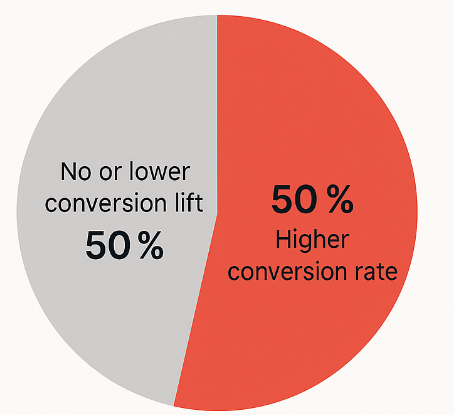This article explores the science behind what makes users click, act, and convert.
In a world where consumers are constantly bombarded with digital content, standing out isn’t just about design or copy. It’s about psychology. Every click, every scroll, every pause reflects a mental process that can be understood and optimized. The key to turning impressions into intent lies in understanding how people think, feel, and decide online.
The Power of First Impressions
Studies show that users form an opinion about an ad within 50 milliseconds. That’s faster than a blink. This first impression determines whether they’ll keep watching, click, or scroll past. The takeaway? Visual hierarchy, color, and clarity are critical. Clean layouts, contrasting CTAs, and emotionally resonant imagery create instant appeal and trust.
Emotion Drives Action

Comparison of conversion success: emotional-content ads vs rational-content ads
Emotion is the invisible engine of decision-making. Research by Nielsen found that ads with emotional content perform twice as well as rational ones. Whether it’s excitement, fear of missing out, or nostalgia, emotional triggers shape how people perceive a brand and what action they take. The best-performing ads don’t just inform—they make people feel.
The Role of Cognitive Biases

Share of campaigns using scarcity tactics that achieved higher conversion rates
Cognitive biases—the shortcuts our brains use to make decisions—are central to ad effectiveness. Consider these key examples:
-
Social Proof: People trust what others approve. Displaying testimonials or user numbers builds credibility.
-
Scarcity Effect: Highlighting limited-time offers increases urgency. One study revealed that scarcity messaging can boost conversions by up to 226%.
-
Anchoring: When presented with multiple pricing options, users often choose the middle one. Smart ad sequencing uses this to nudge choices.
Personalization and the Brain
The human brain responds positively to relevance. Ads that reflect personal interests and behaviors are processed more efficiently by the brain’s reward system. According to a Salesforce report, 84% of consumers say being treated like a person, not a number, is crucial to winning their business. Personalization increases engagement, recall, and long-term loyalty.
The Science of Timing
Timing matters as much as messaging. Studies suggest that conversion rates can rise by up to 23% when ads are shown at times users are most receptive. That’s why understanding user behavior—like browsing patterns or active hours—can dramatically improve ROI.
Conclusion
Turning impressions into intent isn’t just about creative excellence—it’s about psychological insight. By tapping into emotion, timing, and human biases, marketers can design campaigns that truly resonate. In the end, great advertising doesn’t just get seen; it gets remembered and acted upon.

